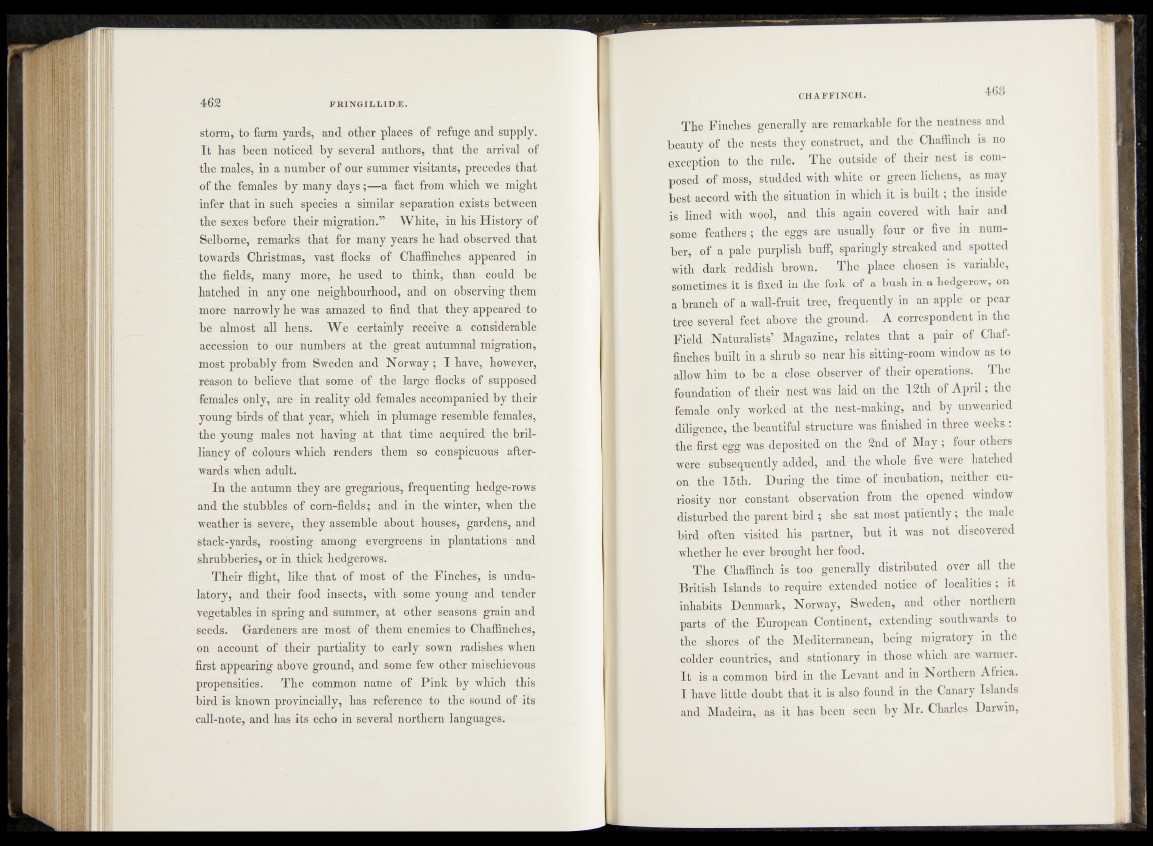
462 F K I N G I L U D .E .
storm, to farm yards, and other places of refuge and supply.
I t has been noticed by several authors, that the arrival of
the males, in a number of our summer visitants, precedes that
of the females by many days ;—a fact from which we might
infer that in such species a similar separation exists between
the sexes before their migration.” White, in his History of
Selbome, remarks that for many years he had observed that
towards Christmas, vast flocks of Chaffinches appeared in
the fields, many more, he used to think, than Could be
hatched in any one neighbourhood, and on observing them
more narrowly he was amazed to find that they appeared to
be almost all hens. We certainly receive a considerable
accession to our numbers at the great autumnal migration,
most probably from Sweden and Norway; I have, however,
reason to believe that some of the large flocks of supposed
females only, are in reality old females accompanied by their
young birds of that year, which in plumage resemble females,
the young males not having at that time acquired the brilliancy
of colours which renders them so conspicuous afterwards
when adult.
In the autumn they are gregarious, frequenting hedge-rows
and the stubbles of corn-fields; and in the winter, when the
weather is severe, they assemble about houses, gardens, and
stack-yards, roosting among evergreens in plantations and
shrubberies, or in thick hedgerows.
Their flight, like that of most of the Finches, is undu-
latory, and their food insects, with some young and tender
vegetables in spring and summer, at other seasons grain and
seeds. Gardeners are most of them enemies to Chaffinches,
on account of their partiality to early sown radishes when
first appearing above ground, and some few other mischievous
propensities. The common name of Pink by which this
bird is known provincially, has reference to the sound of its
call-note, and has its echo in several northern languages.
The Finches generally are remarkable for the neatness and
beauty of the nests they construct, and the Chaffinch is no
exception to the rule. The outside of their nest is composed
of moss, studded with white or green lichens, as may
best accord with the situation in which it is built ; the inside
is lined with wool, and this again covered with hair and
some feathers ; the eggs are usually four or five in number,
of a pale purplish buff, sparingly streaked and spotted
with dark reddish brown. The place chosen is variable,
sometimes it is fixed in the fork of a bush in a hedgerow, on
a branch of a wall-fruit tree, frequently in an apple or pear
tree several feet above the ground. A correspondent in the
Field Naturalists’ Magazine, relates that a pair of Chaffinches
built in a shrub so near his sitting-room window as to
allow him to be a close observer of their operations. The
foundation of their nest was laid on the 12th of A pril, the
female only worked at the nest-making, and by unwearied
diligence, the beautiful structure was finished in three weeks :
the first egg was deposited on the 2nd of May ; four others
were subsequently added, and the whole five were hatched
on the 15th. During the time of incubation, neither curiosity
nor constant observation from the opened window
disturbed the parent bird ; she sat most patiently; the male
bird often visited his partner, but it was not discovered
whether he ever brought her food.
The Chaffinch is too generally distributed over all the
British Islands to require extended notice of localities ; it
inhabits Denmark, Norway, Sweden, and other northern
parts of the European Continent, extending southwards to
the shores of the Mediterranean, being migratory in the
colder countries, and stationary in those which are warmer.
It is a common bird in the Levant and in Northern Africa.
I have little doubt that it is also found in the Canary Islands
and Madeira, as it has been seen by Mr. Charles Darwin,